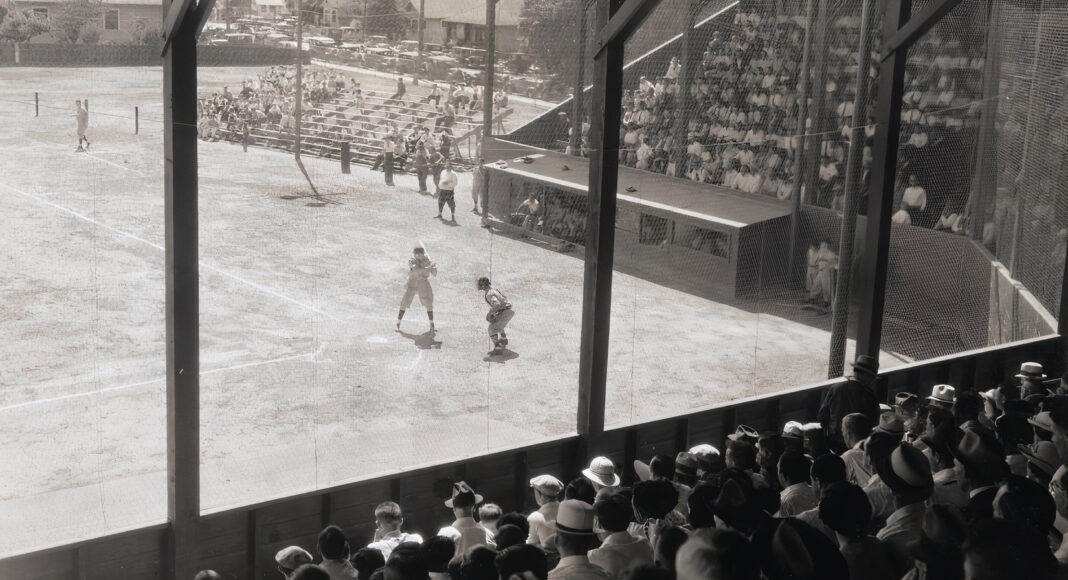The noir atmospherics of Willow and Mastic at nighttime recently conjured the ghosts of Joe DiMaggio and Mercury-News reporter Harry Farrell.
La Mejor Taqueria at 102 Willow is a brightly colored place. With fresh coats of green, yellow and red, it stands out in the neighborhood. Just before closing time, though, I am the only one inside. I gaze out the window, across the dark parking lot, and see the scrolling LED signage at the gas station next door as it reflects onto the houses across Willow. The digital gas prices likewise flicker in the darkness.
This is an old neighborhood, a place once known as Goosetown, a locale that evolved through several generations of immigrants, perhaps most notably the Italians. Old city directories are jammed with musical-sounding surnames like Compagno, Gibino, Sanfilippo and Bonacorso, back in the days when business owners actually lived down the street, or even upstairs above their shops.
Harry Farrell, perhaps the best true crime author this town ever produced, lived across the street for the first four years of his life, in the ’20s, at 95 Willow. On the corner is now a single-story religious facility in a former auto glass business.
Farrell, the definitive old-school newspaperman, a guy who only used two fingers to type, spent at least 50 years writing for the Merc and also penned the award-winning book Swift Justice, about the infamous lynching in St. James Park, a book all San Joseans should read. Farrell ran with every local and state-level politician throughout the ’50s, ’60s and ’70s. He knew several US presidents.
But Farrell’s past likeness is not the only reason I’m sitting here at La Mejor Taqueria with a grilled chicken burrito. You see, this very spot, Willow and Mastic, used to be Graham Field, a long-forgotten baseball park that existed from 1935 until some stray kids burned it down in 1947. The park featured a 1,200-capacity wooden grandstand and cost $9,000 to build. DiMaggio actually played here. The park was named after Jack Graham, another legendary newspaperman and baseball writer for the San Jose Mercury Herald, as it was then known. A pillar of the community, Graham went down in history as the father of sandlot baseball in San Jose.
Farrell mentioned some of these details in one of his other books, a large hardback compendium, San Jose and Other Famous Places, published in 1983. Graham Field appears in the very first pages, both in cartoon form and in text. In those pages, Farrell writes about his youth in the neighborhood.
“One of my earliest memories is of goats pastured across the street, on the south side of Willow, in a field that also served as a playground for Washington School, a block north,” Farrell writes. “The school was a homely, turn-of-the-century structure with a Victorian cupola topped by a flagpole I distinctly remember as crooked. How it got that way I have no idea. Lightning maybe.”
The goats were gone by 1935 when the ballpark was built. Sadly, Graham Field lasted only 12 years before going up in flames one sordid night. Yet the city didn’t seem to care at all. The San Jose Unified School District, who owned the property, offloaded it to real estate developers for $69,500. The area was then rezoned, clearing the way for what’s now Graham Avenue to run diagonally from Willow to Goodyear, thus linking the two streets into a major crosstown artery. Goodyear continues on to become Keyes, which then becomes Story Road.
Nowadays, the short couple blocks of Graham Ave are ridden with horrendous potholes. It’s a janky stretch of road highlighted by the gas station and a slew of $15 Sewer & Drain trucks. Graffiti adorns the landscape. Aromas of urine and motor oil dominate. Stacks of crumbling apartments feature signs with mismatched lettering. Upturned piles of broken furniture lay strewn about the sidewalk. I’m not sure Jack Graham would be proud.
Yet on this dark night, I am happy to visit La Mejor Taqueria, one of the few newly painted spots in the neighborhood. The burrito is quite good. The crispy flour tortilla is grilled to perfection. I never knew Harry Farrell personally, but I’m sure he would approve.




I have read many of your Columns Mr. Singh and you shoot off at the mouth pretty recklessly when it comes to Chicanos and Mexicans whom you know for a fact populate these Barrios . The Racist Policies of Redlining impacted these Barrios in ways that you just outlined however you continue to demonstrate your degree of ignorance which is grande and your propensity to subtle and nuanced racist classist views of Mexican Chicano Barrios.
It’s human beings like you that smell of Urine and waste with your subtle backhanded way of villifying My Barrio and I am getting really sick of it Homeboy.
I own a house across the street from what used to be Graham Field. Quite a surprise seeing this article—and my house. In the 1970s, the Mercury News published a very different story of the park, fire, ownership of the land and the creation of Graham Ave. I met Harry Farrell a number of times over the decades. I wish that I had known where he grew up so that I could have asked him questions. I’ve no doubt that, if his book is your source, it’s more accurate than that ’70s article.